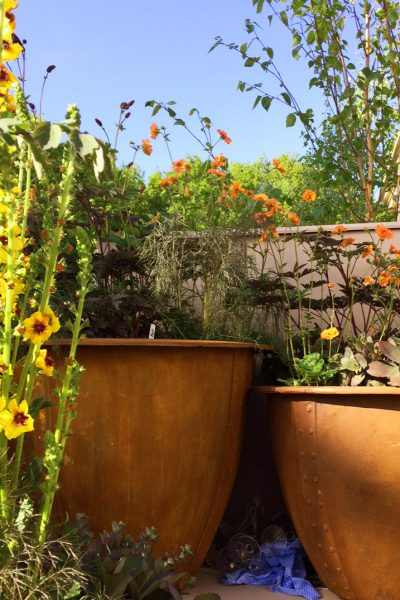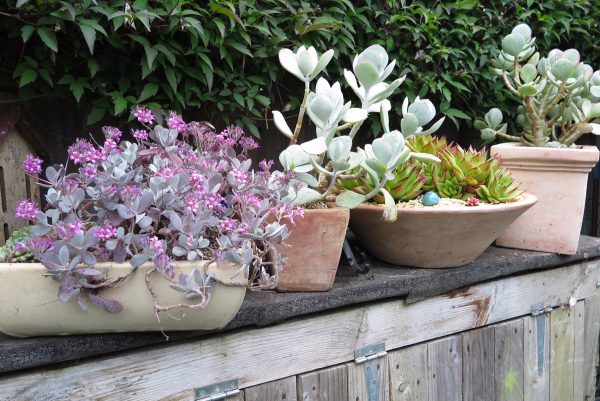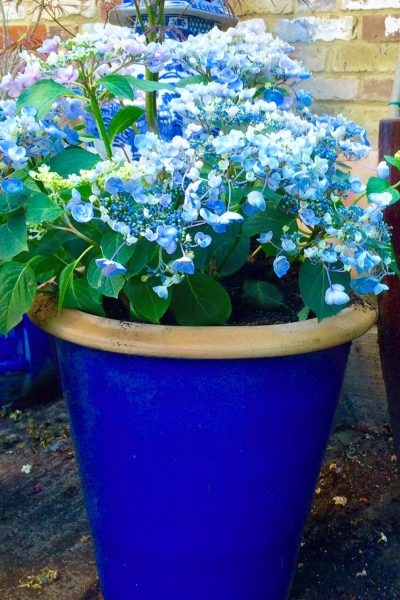What are ‘low maintenance garden pots’? After all, how low can you go?
Can you go away on holiday for a fortnight without asking anyone to water your pots?
Er, no. Not unless you invest in a watering system. The first thing to make clear is there is no such thing as the ‘no-maintenance garden pot’. All plants need some care.
But my friend Debs has a charming arrangement of pansies on her terrace. They flowered from October to May. She only waters them, and feeds them once the growing season starts. I call that low-maintenance.

They’ve been flowering for six months on minimum care. I particularly like the way Debs has chosen just one colour of pansy for all her pots – it lends a bit of style to a humble pot plant.
This post is sponsored by Phostrogen plant foods and Baby Bio Pour & Feed ready-to-use plant food.
However, I’ve chosen the topic – because my definition of ‘low maintenance garden pots’ are pots that only need watering and feeding (and all plants in pots, however low maintenance, do need watering and feeding!). All opinions are my own, and based on my own experience.

Phostrogen Patio Plant Foood, Phostrogen Slow Release & Moisture Control Plant Food and Baby Bio Pour & Feed Ready to Use Plant Food ready for action in the Middlesized Garden.
Large pots are more ‘low-maintenance’ than small ones…
I once offered to look after a friend’s plants while she was away. She had about thirty very small pots scattered around in ones and twos in her courtyard garden and up the steps from her basement flat.
I put all the pots together in the bath, and gave them a good soaking. Then I put all them all in one corner together. This helps prevent them from drying out so quickly.
If I hadn’t done that, I’d have had to go in every day to water them. Even so, they had to be watered three times that week, whereas my big pots do fine on one good watering a week.

Large pots, such as these ultra-light fibreglass pots from Capital Garden Products, retain water for longer. So they need less maintenance than having lots of little pots.
You can maximise how often you need to feed and water smaller pots by mixing the compost with a water-control products, such as Phostrogen Slow Release Plant Food & Moisture Control. You could water less and wouldn’t have to feed at all.
However, a very small pot, particularly if it’s very exposed, like the one further down this post, will dry out faster, no matter what you do.
Although succulents may be the exception…
Everyone always says that succulents are perfect for ‘low maintenance garden pots.’ I am not quite convinced, as mine get ratty-looking very quickly.

These succulents look so charming in this Whitstable garden. But I suspect the garden owners are better gardeners than I am, as I have never succeeded in getting pots of succulents to look that good.
Succulents certainly need less water than most pot plants, and less food, too. Most pot plants need to be fed every two weeks, but you can feed succulents once a month with a well-balanced fertiliser, such as Phostrogen Patio Plant Food.
But they can be picky in other ways. They don’t like getting wet feet, for example, and need plenty of drainage in their pot. I think mine have rotted because their pots get saturated when it rains.
They have been brilliant on a plant stand, however. My mother had a 1960s plant stand (pictured below). She used to grow blue trailing lobelias (which, coincidentally, she fed with Phostrogen).
I inherited the plant stand, but have found it very difficult to make a success of it. My mother was happy to water plants in pots every day. I am not. The pots dry out so quickly in the air.

Most plants on a stand like this dry out very quickly, so it’s ideal for succulents.
Box is my No 1 low maintenance garden pot plant
I know everyone is worried about box blight and box tree caterpillar, but my box plants go on and on in their pots.
I may have to change my mind, however. The box tree caterpillar is heading my way, as it is now common in London and the South of England, according to an RHS survey.

This topiary spiral from Bellamont Topiary has been here since September 2015. I haven’t had to trim it, but I water it once a week and have feed it once a fortnight with Phostrogen Patio Pant food.
In theory, you should take your box out of its pot every two years, give it a root trim, then replace it in fresh soil. I will do this for the topiary spiral, but I haven’t for my less elegant box in pots.
I have had these box cones (below) in the same pots for seven years. I water them once a week, and feed them once a fortnight. (Do note when you feed pot plants in your diary – by the end of the summer, one session blurs into another and I can never remember whether I fed the plants last week or the week before.)

This cone is trimmed once a year and watered once a week.
If you’re looking for an alternative to box, I’d recommend yew or another slow-growing evergreen. Buy it at the size you want it, then trim it. If you buy a small one, hoping for it to grow, it will either take a long time or it will need constant trimming once it gets to the size you want.
I’d advise against using ligustrum – I have two lovely privet standards trimmed into lollipops, but they need trimming at least four times a year. Not low-maintenance!
Topiary in pots – high drama, low-maintenance
Topiary in pots gives the garden structure.

Give your garden instant structure with a dramatic piece of topiary. It’s expensive – but cheaper than buying topiary for the garden, and I’ve found it very easy-care.

Cloud-pruned topiary in pots. Very smart. Topiary seems to grow more slowly in pots, so it needs less clipping. Or is that my imagination?
Nepeta and heuchera – two easy-care garden plants for pots…

Before the topiary spiral arrived, Nepeta ‘Six Hills Giant’ made dramatic show in just one season. These stayed in these pots for nearly three years before they gave up the ghost. I simply chopped them back in September and they grew back again with charming grey-blue foliage.The heucheras in the pots in the foreground were extremely low-maintenance too. They lasted two years in the same compost before they were eaten by vine weevils.
Hydrangeas in pots for easy, late-season gorgeousness
Several of my friends swear by hydrangeas as the ultimate easy-care plant for garden pots. They don’t like being short of water, but otherwise seem remarkably unfussy and have a great winter presence.

Hydrangeas in pots: easy to look after. And you can also have blue ones, even if your soil isn’t right as you can put ericaceous compost in the pot.
Friends swear by Hydrangea paniculatas as ideal for low maintenance garden pots.
Plectranthus is good for low maintenance garden pots
This photograph, taken at Doddington Place Gardens, is one of my favourites from last year. The silvery-grey plectranthus looked so simple and elegant all summer long in the copper pots. And the plectranthus is very forgiving, even surviving a shortage of water.

The plectranthus in these lovely copper pots at Doddington Place Gardens even survive being a bit short of water.
Grasses are brilliant for low maintenance garden pots
I’d suggest buying the right size grass for the pot, however. I bought some panicum virgatum ‘Shenandoah’ eighteen months ago. They’ve looked a bit forlorn in the middle of a large pot, although I surrounded it with petunias.

Panicum virgatum ‘Shenandoah’, surrounded by petunias, in its first year in the pot. I had to deadhead the petunias occasionally, but the panicum was fine with weekly watering and a fortnightly feed.
I should probably have started them off in a smaller pot, then transferred them up in size. But that sort of fiddling-around breaks the ‘low-maintenance’ barrier.
In theory, I should lift and divide my grasses every two years, replacing them in new container soil. I may allow them to get thoroughly congested, as I’ve seen a congested panicum ‘Shenandoah’ look fabulous when it was bursting out of its pot.

Grass at the centre of a large planter at Doddington Place Gardens – very easy care.
Grasses in pots look good in the winter, too. I left mine until around February, and it only took ten minutes to give the four pots a haircut.

Panicum virgatum ‘Shenandoah’ adding a fountain of grasses to our winter garden.
The secret of a good low maintenance trough…
It may just be me, but I have never succeeded in planting and maintaining a beautiful old trough I was given.
And when I look inside friends’ luscious and romantic troughs, I see that they have simply inserted a grouping of plants in their plastic pots.
Having lots of smaller pots corralled together in a trough isn’t too bad on the watering, as they won’t dry out as fast as they would if they were scattered around on their own.

I’ve given up planting up this trough. I bought some pink marguerites and cosmos from the market and simply popped them, keeping them in their original pots. It took just a few minutes, and if one of them doesn’t do well, I can take it out and substitute it.
About Phostrogen plant foods and Baby Bio Pour & Feed

Phostrogen All Purpose Plant Food
Phostrogen All Purpose Plant Food is a balanced plant food for all garden plants, including shrubs, bedding plants, pots, vegetables and hanging baskets. It can be used either dissolved in water or sprinkled directly on the soil.
Phostrogen Slow Release Plant Food & Moisture Control will feed your pot for 6 months and reduces watering by 75%. Mix it in with your compost when you’re planting the pot up.
Phostrogen Patio Plant Food is for a balanced plant food for pots, containers and hanging baskets, including vegetables, hanging baskets and indoor plants. Use as a dilute solution or sprinkle directly onto the soil.
Baby Bio Pour & Feed is a ready-to-use balanced plant for all container plants. Just measure into the cap and pour around the soil.
The ultimate low maintenance garden pot
Leave the pot empty! Empty pots can look wonderful. Although I have discovered that empty pots are soon colonised by ivy or other plants, which often looks even nicer.
Pin this for later:
The post The best plants for amazingly low maintenance garden pots appeared first on The Middle-Sized Garden.
from The Middle-Sized Garden http://www.themiddlesizedgarden.co.uk/the-best-plants-for-amazingly-low-maintenance-garden-pots/

No comments:
Post a Comment